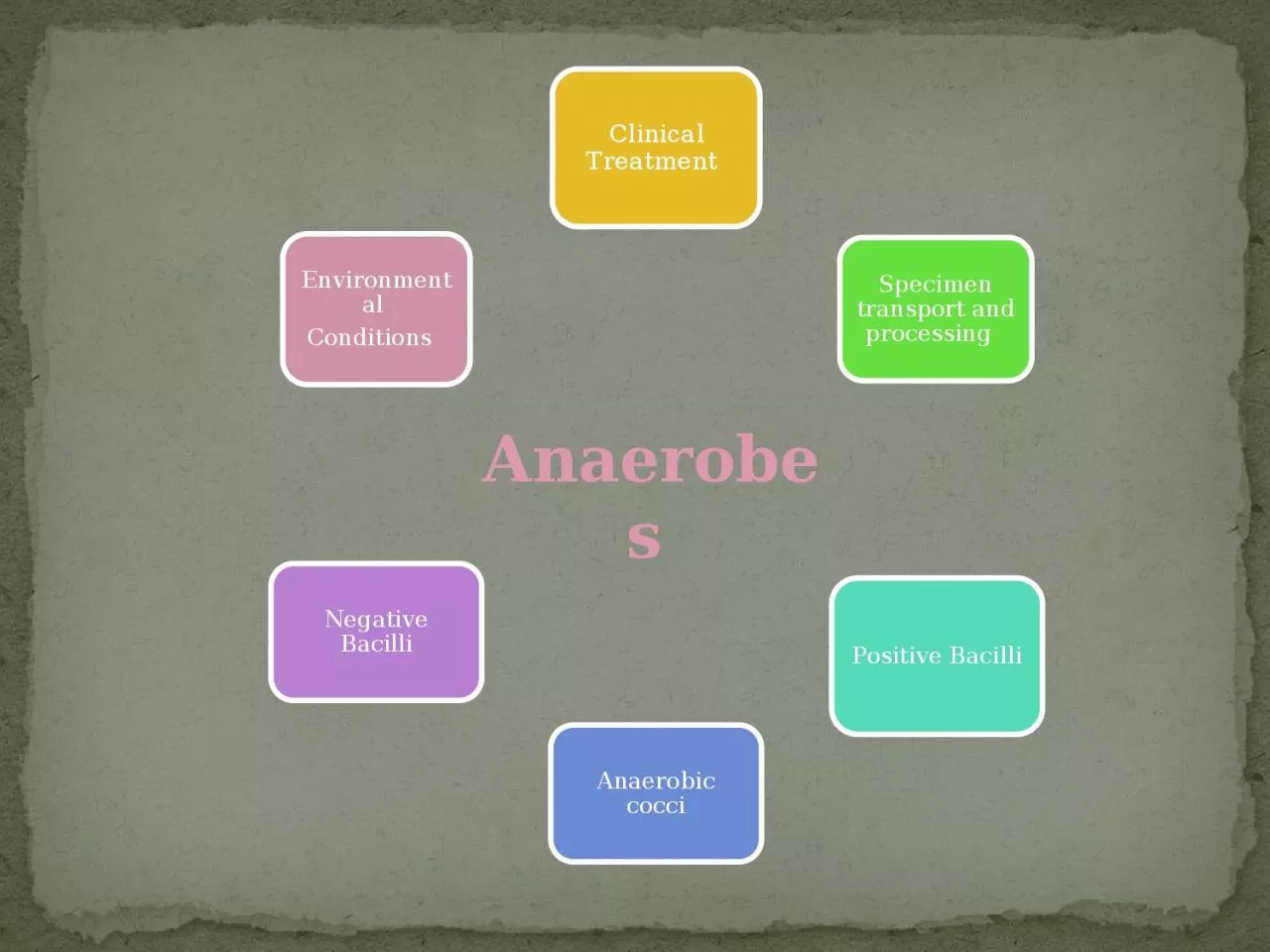

only grow in the absence of oxygen O2 Aerotolerant Microaerophilic anaerobes grow in reduced concentration of oxygen 5 O2 but grow best under strict anaerobic conditions ID: 935152
Download Presentation The PPT/PDF document "Anaerobes Obligate Anaerobes" is the property of its rightful owner. Permission is granted to download and print the materials on this web site for personal, non-commercial use only, and to display it on your personal computer provided you do not modify the materials and that you retain all copyright notices contained in the materials. By downloading content from our website, you accept the terms of this agreement.
Slide1
Anaerobes
Slide2Obligate Anaerobes
only grow in the absence of oxygen (O2)
Aerotolerant / Microaerophilic anaerobes grow in reduced concentration of oxygen (~5% O2), but grow best under strict anaerobic conditions
Environmental Conditions
Slide3Peptostreptococcus
Vieonella
??? Get correct spelling Anaerobic cocci
Slide4Peptostreptococcus
(
Peptoniphilus) spp. Intestinal gram positive cocci
Key reactions
Nitrate (+)
SPS –sensitive
Indole (-)
P.
assacharolyticus
Form tetrads or pairs
Key reactions
:
SPS resistant, Indole (+), Nitrate (-)
P.
anaerobius
Elongated
Produce sweet odor due to the presence of
isocaproic
acid
Causes:
Head, neck , genital and gut infections
Slide5Viellonella
species
Key reactions
Nitrate (+)
Non-fluorescent, may pigment red
Causes :
Endocarditis
and
bacteremia
Indigenous to
oral cavity, upper respiratory, G.I
and
genitourinary tract
Kanamycin (S )
Vancomycin (R )
Colistin
(S)
Small
Gram negative
cocci
Slide6Clostridium species
Others ????? Positive Bacilli
Slide7Clostridium
spp.
Gram positive rods
Causes :
Food poisoning
Gas gangrene(
myonecrosis
)
Neoplasm s
Lock jaw
Pseudomembraneous
colitis
Spore formers
Found commonly in stool specimen
Produce Virulence factors
that are responsible for infections
Four common species
Clostridium
perfringens
Clostridium difficile
Clostridium
tetani
Clostridium botulism Other Clostridium
Slide8Appearance: box-shaped gram positive rod
Two zone beta hemolytic on SBA
Produces alpha and Theta toxinKey reactions:Lecthinase (+), nitrate (+) Reverse camp with group B Strep.Stormy fermentation of litmus milkKanamycin (S ), Vancomycin (S), Colistin (R)Causes:Gas gangrene, Food poisoning (Enterotoxin A), Soft tissue infections in diabetics and Necrotizing bowel disease Clostridium perfringens
Slide9Subterminal spore Chartreuse fluorescence
Key reactions
Ferment fructoseLecthinase (-), Lipase (-)Causes:Pseudomonas colitis and Antibiotic associated diarrhea (AAD) due to enterotoxin A and BClostridium difficile
Slide10Toxin: tetanospasmin
(
neurotoxic exotoxin)Motile, swarms Appearance: Gram positive rods. Produce terminal spores that appear as drumsticks Biochemical reactions:Lipase (-), Indole (+)Causes:Lockjaw, respiratory failure and tetanus neonatorum Clostridium tetani
Slide11Toxin: botulin
Key reaction:
Lipase (+)Causes:Botulism: Inhibits acetlycholine release from motor neuronsClostridium botulism
Slide12Clostridium
novyi
Beta hemolytic Key reactions:Lecithinase (+), lipase (+), indole (-), urease (-)Causes: Gas gangrene (myonecrosis) and toxic shockRapid swarmerCharacteristic:
medusa head, subterminal sporesKey reactions:Lipase (-), Indole (-)
Causes
:
Neoplasm of the colon, breast
leukemia, lymphoma,
enterocolitis
.
myonecrosis
Other Clostridium spp.
Clostridium
septicum
Slide13Lactobacillus
Gram positive
Non-spore forming bacilliNormal flora in the oral cavity, G.I. and female genital tract
Protect
female genital tract
Produce lactic acid
to
lower vaginal pH
Infections caused
:
Bacterial
vaginosis
Pelvic inflammatory disease
Key reactions
Catalase (-)
Cephalosporin (R)
Vancomycin (R )
Slide14Proprionibacterium
acnes
Gram positive Non-spore forming bacilli (appear as diptheroids)Normal flora of the skin
Can cause
:
Subacute
bacterial
endocarditis
Bacteremia
Reactions
Catalase (+)
Indole (+)
Nitrate (+ )
Slide15Bacteroides
fragilis
Bacteroides ureolyticusFusobacterium nucleatumFusobacterium
necrophorumOther
Fusobacterium
Porphyromona
spp.
Prevotella
spp.
Negative Bacilli
Slide16Bacteroides
fragilis
Key reactions
Catalase (+)
Indole (-)
Nitrate (-)
Bile tolerant, Non-motile
Causes :
Inflammation of the intestinal wall
Septic abortion
Thrombosis
G.I. infections
Gram negative rod
Penicillin (R )
Kanamycin (R )
Vancomycin (R )
Colistin
(R )
Clindamycin
(S)
Slide17Bacteroides
ureolyticus
Key reaction
Urease (+)
Bile sensitive, Non-motile
Causes :
Respiratory infections
Intestinal tract infections
Gram negative rod
Kanamycin (S )
Vancomycin (R )
Colistin
(S)
Slide18Fusobacterium
nucleatum
Key reactions
Lipase (-)
Indole (+)
Causes :
Metastatic brain abscess
Fusiform
Gram negative bacilli
Kanamycin (S )
Vancomycin (R )
Colistin
(S)
Slide19Fusobacterium
necrophorum
Key reaction
Lipase (+)
Causes :
Pertonsillar
abscess in children and young adult
Pleomorphic
filamentous gram
negative rod
Slide20Prevotella
melaninogenica Gram negative coccobacilli
Produces foul odor
Slow producer of
protoporphin
Causes :
Lung and dental infections
Normal flora in the oral, G.I and vaginal area
Kanamycin (R )
Vancomycin (R )
Colistin
(S)
Penicillin (R)
Slide21Acceptable specimens :
Aspirates from sterile site deep wounds , bodily fluids (except urine, sputum and saliva), and suprapubic bladder aspirates
Primary media: Brucella (CDC or Schaedler) blood agar- contains hemin, vitamin K and yeast extract. Detect hemolysis in anaerobesSpecial media:Bacteroides bile esculin (BBE) agar- contains gentamycin (inhibits facultative aerobic gram negative rods ) and 20% bile. Laked Kanamycin Vancomycin (LKV) blood agar – identify pigmented gram negatives . (Kanamycin inhibits facultative gram negative rods and
Vancomycin inhibits gram positive rods)Phenyl-ethyl Alcohol (PEA) plate : inhibits swarming
Cycloserine cefoxitin fructose (CCFA) agar
:
selective for Clostridium difficile
Egg yolk agar-
selective for Lecithinase and lipase production
Thioglycollate broth
: provides reduced O2 environment
Specimen transport and processing
Slide22Identification tests :
Catalase test
: distinguish aerotolerant anaerobes from anaerobic organisms Indole: identify organisms that produce tryptophanase (Note: media needs to contain tryptophan) Nitrate test:Urea test: identify organisms that produce urease. Observe pH change. Urea is converted to ammoniaIncubate media in anaerobic gas chambersContains H2, N2, carbon dioxide , palladium catalyst and desiccants (absorb water) Keep media for 7 days Specimen transport and processing
Slide23Metronidazole – best treatment
. Confirms the presence of an anaerobe
Clostridium infection: Use antitoxins , antibiotics (i.e. Chloramphenicol, pipercillin, imipramine or ampicillin/sulbactam) and supportive therapy Clinical Treatment